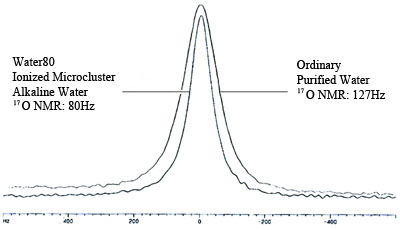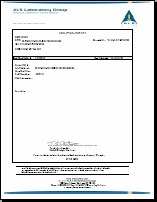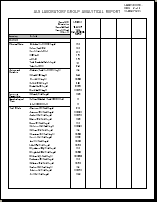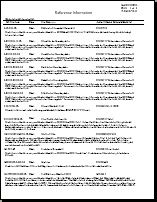Lab Test Report of Water80 Ionized Microcluster Alkaline Water
Structure of Water
A water molecule consists of two hydrogen atoms and one oxygen atom.

Water molecules are held together by hydrogen bonding which occurs when a hydrogen atom is shared between two water molecules, so that it may be considered to be acting as a bond between them.
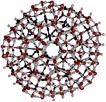
Water molecules surrounded by hydrogen bonds tend to clump together, forming clusters. Tap water has very large clusters (more than 10 molecules per cluster), so does filtered water, purified water and a majority of mineral water and spring water. Ionized Microcluster Alkaline Water has large water clusters reduced from their original size into so called 'micro clusters' (5 to 8 molecules per cluster).

Ionized Microcluster Alkaline Water contains much more micro clusters than those found in tap water, filtered water, purified water, bottled mineral water and bottled spring water. The smaller cluster size and increased number of micro clusters give the water excellent cellular hydrating property, high solubility, alkaline pH and good permeability. These properties make the water functional and effective at improving health especially chronic disease.
Water80 Ionized Microcluster Alkaline Water
In the world's well-known longevity zones, microclustered spring water is naturally formed and plays a key factor in health and longevity. The half line width of 17O NMR (Nuclear Magnetic Resonance) curve of natural Ionized Microcluster Alkaline Water is around 80Hz which indicates smaller size of water clusters. On the other hand, the half line width of 17O NMR curve of tap water, bottled water and other purified water is above 100Hz indicating large water clusters.
Natural microclustered spring water is protected from commercial development. However with our patent pending Ionized Microcluster Alkaline Water Generator, tap water at your home can be turned into Ionized Microcluster Alkaline Water with the same 80Hz half line width of 17O NMR curve as natural microclustered water. In addition, it becomes stable alkaline water with pH value around 8.0, the same pH value of healthy human blood. That's why we use Water80 as our company name.
ALS Laboratory is one of the largest, most geographically-diverse environmental testing companies in the world, and it is approved by B.C. Provincial Health Officer for drinking water testing in Canada. Below is ALS Laboratory's analysis on Water80 Ionized Microcluster Alkaline Water comparing to Vancouver tap water. Water80 Ionized Microcluster Alkaline Water is cleaner than bottled water. Its Total Dissolved Solids equals to 21 ppm, whereas (Total Dissolved Solids of Coca-Cola's DASANI bottled water is 35 ppm, and it meets and in some cases outperforms the criteria defined in Guidelines for Canadian Drinking Water Quality and United States National Primary Drinking Water Regulations:
| Before Filtration: Vancouver Tap Water |
After Filtration: Water80 Ionized Microcluster Alkaline Water |
Guidelines for Canadian Drinking Water Quality U.S. National Primary Drinking Water Regulations |
|
| Physical Tests | |||
| Hardness (as CaCO3) (mg/L) | < 7.0 < sign means less than the minimum detection limit of lab equipment. |
N/A | |
| Colour, True (CU) | < 5.0 < sign means less than the minimum detection limit of lab equipment. |
Canadian Standard: < 15 U.S. Standard: < 15 |
|
| Conductivity (uS/cm) | 31.1 | N/A | |
| pH | 6.25 Acidic | 8.05 Alkaline | Canadian Standard: 6.5-8.5 U.S. Standard: 6.5-8.5 |
| Total Dissolved Solids (mg/L, ppm) | > 600 | 21 | Canadian Standard: <=500 U.S. Standard: <=500 |
| Turbidity (NTU) | 0.8 > 1 during raining seasons |
0.14 | Canadian Standard: < 0.3 U.S. Standard: <0.3 |
| Dissolved Anions | |||
| Alkalinity-Total (mg/L) | 3.1 | 8.6 | |
| * Alkalinity-Total (also called Total Alkalinity) is a measure of the pH-buffering capacity of water or the water's resistance to change in pH. Therefore, the alkaline pH of Water80's Ionized Microcluster Alkaline Water is very stable. | |||
| Chloride (mg/L) | 2.46 | Canadian Standard: < 250 U.S. Standard: < 250 |
|
| Fluoride (mg/L) | <0.020 | 0.024 | Canadian Standard: < 1.5 U.S. Standard: < 4.0 |
| Metals Healthy to Human Body | |||
| Calcium (mg/L) | 1.22 | 2.6 | N/A |
| Magnesium (mg/L) | 0.15 | 1.0 | N/A |
| Zinc (mg/L) | <0.0050 | 0.50 | Canadian Standard: < 5.0 |
| Ingredients | |||
| Calories | 0 | 0 | N/A |
| Fat (mg/L) | 0 | 0 | N/A |
| Protein (mg/L) | 0 | 0 | N/A |
| Sugar (mg/L) | 0 | 0 | N/A |
| Chlorine Test (Harmful to Human Body) | |||
| Chlorine Total (mg/L, ppm) | < 0.2 < sign means less than the minimum detection limit of lab equipment. |
Canadian Standard: In preparation U.S. Standard: < 4.0 |
|
| Total trihalomethanes (THMs) (mg/L, ppm) | < 0.005 < sign means less than the minimum detection limit of lab equipment. |
Canadian Standard: < 0.1 U.S. Standard: < 0.08 |
|
| Bacteriological Tests (Harmful to Human Body) | |||
| Coliform Bacteria - Total (MPN/100mL) | < 1 Not detected. < sign means less than the minimum detection limit of lab equipment. |
Canadian Standard: Not detected U.S. Standard: Not detected |
|
| E. coli (MPN/100mL) | < 1 Not detected. < sign means less than the minimum detection limit of lab equipment. |
Canadian Standard: Not detected U.S. Standard: Not detected |
|
| Nutrients (Indicates Water Pollution Level, Harmful to Human Body) | |||
| Nitrate Nitrogen | 0.0717 | 0.0321 | Canadian Standard: < 45 U.S. Standard: < 10 |
| Nitrite Nitrogen | 0.0025 | < 0.0010 | Canadian Standard: < 3.2 U.S. Standard: < 1 |
| Heavy Metals (Harmful to Human Body) | |||
| Antimony (mg/L) | 0.20 | < 0.005 < sign means less than the minimum detection limit of lab equipment. |
Canadian Standard: < 0.006 U.S. Standard: <0.006 |
| Arsenic (mg/L) | 0.20 | < 0.001 < sign means less than the minimum detection limit of lab equipment. |
Canadian Standard: < 0.01 U.S. Standard: < 0.01 |
| Cadmium (mg/L) | 0.01 | < 0.002 < sign means less than the minimum detection limit of lab equipment. |
Canadian Standard: < 0.005 U.S. Standard: < 0.005 |
| Lead (mg/L) | 0.05 | < 0.010 < sign means less than the minimum detection limit of lab equipment. |
Canadian Standard: < 0.01 U.S. Standard: < 0.015 |
| Mercury (mg/L) | < 0.00020 < sign means less than the minimum detection limit of lab equipment. |
Canadian Standard: < 0.001 U.S. Standard: < 0.002 |
|
Click on the images below to view the original and complete report:
